Some Spectrum Policy Issues Are Not Economic But Really Life or Death Ones
But the statement was a learning experience. Much of what FCC does is really "economic regulation":
- it affects how much income licensees and regulated entities such as carriers can earn,
- it affects the division of spectrum among industries which indirectly affects their profitability,
- it deals with who can own certain types of licenses and how many of those licenses they can own,
- it affect inter service interference which also affect profitability, etc.
For the purpose of regulating interstate and foreign commerce in communication by wire and radio so as to make available, so far as possible, to all the people of the United States, without discrimination on the basis of race, color, religion, national origin, or sex, a rapid, efficient, Nation-wide, and world-wide wire and radio communication service with adequate facilities at reasonable charges, for the purpose of the national defense, for the purpose of promoting safety of life and property through the use of wire and radio communications, and for the purpose of securing a more effective execution of this policy by centralizing authority heretofore granted by law to several agencies and by granting additional authority with respect to interstate and foreign commerce in wire and radio communication, there is created a commission to be known as the "Federal Communications Commission", which shall be constituted as hereinafter provided, and which shall execute and enforce the provisions of this chapter.
So safety issues should be deep in FCC's DNA. The creation of the Public Safety and Homeland Security Bureau on 9/25/2006 was a positive attempt to get public safety issues away from the main industry focused bureaus of FCC that in many respects like most regulators were captured to some degree by the commercial entities they regulate. Hence WTB was really unable to resolve the long standing NEXTEL/public safety interference issue of the late 1990s and it was only resolved when Nextel came in with a "deal" that public safety entities were willing to agree with - whether or not it was really in the public interest.
(There is an oral tradition in the FCC staff that an engineer of WTB's predecessor was concerned about the possibility of such interference and pressed for protection of public safety as a condition of the original Nextel waiver that permitted their Part 90 licenses to be used for cellular-like technology. However, this was overruled by higher level managers who were focused on the issue of increasing competition in the cellular industry. Hopefully with the creation of PSHSB such decisions will not be so one-sided in favor of commercial interests.)
But there are a few ongoing spectrum policy issues that are really related to life or death issues and that the Commission is not resolving expeditiously. Here are some of them:
Texting & driving. CDC states "Each day in the United States, over 8 people are killed and 1,161 injured in crashes that are reported to involve a distracted driver." While FCC has a webpage entitled "The Dangers of Texting While Driving" and another entitled "Distracted Driving", what is it really doing to decrease the number of deaths associated with this use of FCC licensed technology? Is FCC really paying more attention to CTIA's desires on this issue than on the overall public safety issue? How often are senior FCC officials talking about the death toll resulting from this misuse of radio technology? FCC held a "Distracted Driving Technology Showcase" in April 2013. What has been the progress of implementation of such technology on either a voluntary or mandatory basis? NYTimes recently had a discussion on this issue, but is FCC actually doing anything?
Capt. Robert Johnson (Ret.) SCDC, shot 6 times
as a result of an order given over a contraband
cellphone, with Gov. Haley & Comm. Pai.
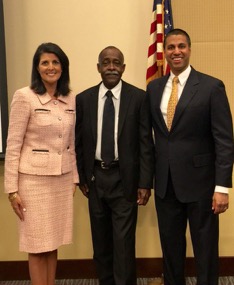
Use of contraband cellphones in prisons. This is the subject of Docket 13-111. Note the first 2 digits are "13" indicating that this NPRM was issued in 2013, actually 3 years ago this week. But this NPRM was in turn based in part on a petition filed by the South Carolina Department of Corrections in July 2009 which was never even put out for public comment. (This explains why the NPRM cryptically refers to the SCDC petition by the mysterious code "PRM09WT" rather than the usual RM number.) But the CTIA-favored approach of "managed access" and continuing the absolute prohibition of any jamming by nonfederal users is basing all progress on a quixotic technology. Meanwhile real people die as a result of crimes ordered by incarcerated criminals. Can't FCC give the cellular industry a date certain to show whether managed access under their preferred approach and conditions is an adequate solution for this life or death issue?
Aviation Tower Marking and Lighting Enforcement: One of the more bizarre statements in the nearly $1M study FCC ordered to justify downsizing field enforcement that has never been formally released (but a leaked version was first made available on this blog) is shown below:
Since tower inspection compliance is good, it can be cut back significantly the consultants reason. But tower lighting and marking issues are different than most other FCC compliance issues like frequency and power regulation. As the Coinjock NC helicopter crash incident dramatically showed major screwup can result in multiple deaths. This different than interference which is typical of most Title III technical violations.
Instrument Landing System (ILS)
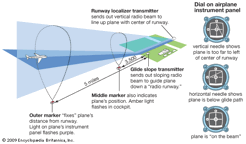
FM Pirate Interference to Aircraft Navigation: As we have written previously, the FAA's Instrument Landing System has its "localizer" (left/right determination) signal just above the FM broadcast band. ILS receivers have some sensitivity to interference resulting from overloads of two signals that have a certain relationship to the ILS channel used at a given airport and another local FM station. In normal FM licensing this is considered and the threatening frequency is not allowed near an airport. But illegal FM stations do not go through normal licensing! And if the mathematical relationship with another FM station and the ILS frequency is correct, not much power is needed to create interference if the other FM station has a strong signal near the airport. So downsizing enforcement without leaving an alternative mechanism to address this issue is an invitation to aviation safety issues.
Public Safety Interoperability: The January 13, 1982 Air Florida crash in the Potomac River was the beginning of a national dialogue on public safety interoperability. The 9/11 tragedy was another milestone.
There have been improvements since 1982, but has it really been adequate. Now there are a lot of agencies involved in this area and Congress has had a key role in starting FirstNet. But FirstNet is not going to make a big dent in the basic problem for this is what its website says:
FirstNet will enhance public safety communications by delivering mission-critical data and applications that augment the voice capabilities of today’s land mobile radio (LMR) networksWhen the FirstNet network is initially deployed, it will provide mission-critical, high-speed data services to supplement the voice capabilities of today’s LMR networks.
So while the broadband capabilities of FirstNet will be interoperable, today's land mobile radio networks in a myriad of bands will be around for the foreseeable future and will continue to serve as a Tower of Babel as in 1982. Does FCC even talk about this issue?
Basic Problem
Most FCC decision do not involve safety issues and they are basically "economic regulation" in the terms of my former colleague. Thus FCC is structured to deal with such issues.
The few issues that are really matters of life and death do not easily fit into this framework and theus don't get the attention they deserve. The FCC's inability to resolve the issues in Docket 13-111 is a classic ongoing example of this problem. Will FCC ever give the cellular establishment a firm time limit for implementing their preferred solution or will people just continue to die because of this ongoing problem? There are other solutions besides the quixotic "managed access". FCC has moved heaven and earth to meet cellular industry spectrum demands for 4G and 5G, when will the industry either act to decrease the prison contraband problem or stop blocking other solutions?
As Docket 13-111 Lingers Without Resolution, Comm. Pai Tries to Focus Attention on Prison/Cell Phone Crisis
Sobering meeting w/ corrections officials at Georgia prison about serious, growing problem of contraband cellphones. pic.twitter.com/Xbw3SRBCjm
— Ajit Pai (@AjitPaiFCC) October 16, 2015FCC Commissioner @AjitPaiFCC visited Georgia today to learn about the problem of cellphones in prisons. http://t.co/xI9eZq4c79 (from @AP)
— Kate Brumback (@katebrumback) October 15, 2015.@GA_Corrections: on pace to confiscate >8K contraband cellphones this year. Used to place hits, run scams, more. http://t.co/z8Ks8wgqq6
— Ajit Pai (@AjitPaiFCC) October 16, 2015Long time readers will recall that the issue of contraband cell phone use in prisons and countermeasures for dealing with them have been a recurring topic here, even if it is one that the cellular industry thinks should be buried. In general, communication should enhance life and usually does. But large scale use of contraband phones by incarcerated criminals actually threatens life!
Independent FCC action, championed by Comm. Clyburn, has reduced the cost of authorized legitimate pay phone services from prisoners to their families and has somewhat decreased the demand for contraband phones. On May 1, 2013, FCC released the NPRM in Docket 13-111 "to facilitate the development of multiple technological solutions to combat the use of contraband wireless devices in correctional facilities nationwide." This was almost 4 years after the filing of a petition for rulemaking by the South Carolina Department of Corrections and dozens of other state and local corrections agencies that apparently was consigned the FCC's secret petition black hole where it lingered in a corner of ECFS that was unknown to all but a few FCC insiders!
But as the cellular industry demands major changes for US spectrum policy to satisfy their endless appetite for spectrum below 6 GHz - they have only token interest in higher frequencies as can be seen in their minimal comments to FCC and participation in WRC preparation related to higher bands - as the cellular industry demands the lion's share of FCC's ever shrinking resources, they seem to have little or no interest in dealing decisively with this deadly unintended consequence of their present services. They have sent the underfunded and understaffed state and local prison administrators on a quixotic chase of the "holy grail": "managed access" which will solve the technical problem of illicit cellphone use in prisons with zero impact on the carriers' business plans. Indeed, they deny that this will result in any over coverage while at the same time insist that jamming will always results in over coverage. WOW - responsive physics!
In their most recent ex parte meeting with FCC staff in December, CTIA and carrier representatives pressed for "the need for a court order to terminate service to a contraband device" presumably under all circumstances including prisons in remote areas. Contrast this with the views of the American Corrections Association which ask to simplify the disconnect process, require carrier participation in managed access system if requested by prisons, and allow jamming in the location where it is technically possible due to remote locations.
But meanwhile nothing is being resolved at FCC in this life or death matter. Kudos to Comm. Pai for making an onsite visit to learn about the problem. We hope that FCC's delays in this urgent matter, now that 6 years have passed since the South Carolina petition, will soon end.
Marriott Pays $600k Penalty for Wi-Fi Jamming in One of Their Hotels
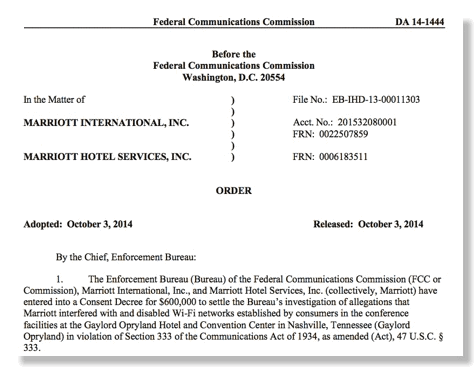
As shown above, FCC released an Order on October 3 terminating an investigation of jamming of Wi-Fi signals at a Marriott hotel by the hotel management with a $600,000 penalty payment. (Until recently such payments were classified by FCC as “voluntary payments” and were tax deductible by the perpetrator - no longer so!)
The press release states
The FCC Enforcement Bureau’s investigation revealed that Marriott employees had used containment features of a Wi-Fi monitoring system at the Gaylord Opryland to prevent individuals from connecting to the Internet via their own personal Wi-Fi networks, while at the same time charging consumers, small businesses, and exhibitors as much as $1,000 per device to access Marriott’s Wi-Fi network.
“Consumers who purchase cellular data plans should be able to use them without fear that their personalInternet connection will be blocked by their hotel or conference center,” said Enforcement Bureau Chief Travis LeBlanc. “It is unacceptable for any hotel to intentionally disable personal hotspots while also charging consumers and small businesses high fees to use the hotel’s own Wi-Fi network. This practice putsconsumers in the untenable position of either paying twice for the same service or forgoing Internet accessaltogether,” he added.
A Washington Post article on the episode was titled “FCC to Marriott: No, you can’t force your customers onto terrible hotel WiFi”. It gives Marriott’s side:
Marriott, in a statement, insisted that its actions were legal and designed to thwart "rogue wireless hotspots.""Like many other institutions and companies in a wide variety of industries, including hospitals and universities, the Gaylord Opryland protected its Wi-Fi network by using FCC-authorized equipment provided by well-known, reputable manufacturers," Marriott said. "We will continue to encourage the FCC to pursue a rulemaking in order to eliminate the ongoing confusion resulting from today's action and to assess the merits of its underlying policy."
Of course, Marriott also sells its own WiFi access for $14.95 a day, sometimes charging for multiple computers in the same room. (It amuses you blogger to observe that cheap hotels such as Quality Inn and Motel 6 generally give free Wi-Fi (often breakfast, too) and charge lower rates than Marriott.
The initial complaint in this case came in March 2013, so the case went from compliant to resolution in 19 months. While this might not seem fast to some, it is much faster than past practice and considering the technical and legal issues involved a timely resolution for string a new precedent a rather timely resolution.
The legal basis for this FCC action was § 333 of the Communications Act , 47 USC 333, a recurring topic here in the context of prison jamming of contraband cellphones. Here is the text of the section:
47 U.S. Code § 333 - Willful or malicious interference
No person shall willfully or maliciously interfere with or cause interference to any radio communications of any station licensed or authorized by or under this chapter or operated by the United States Government.
Clearly Marriott’s action violated this prohibition. While the user’s Wi-Fi system was not “licensed”, it was “authorized” by FCC. Unfortunately, the cellular industry consistently misreads § 333 and tells FCC it means that FCC has no authority to authorize jamming of contraband cellphones in nonfederal prisons, an issue closely related to Docket 13-111.
Prison Cellphone Reply Comments Date Extended
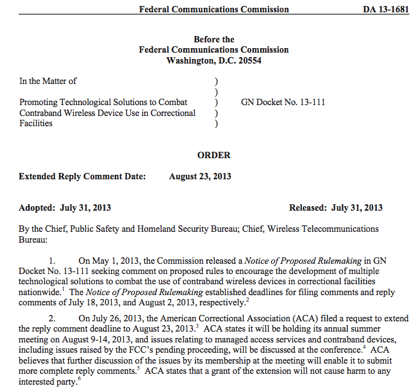
In the above order from FCC, the reply comment date for the cellphones in prison rulemaking, Docket 13-111, has been extended to August 23, 2013.
There is a lot to comment on:
- AT&T objects to requiring a carrier to terminate service to a cell phone identified being in a prison saying it will only do so with an order from FCC or a court. (Perhaps FCC could set up a website and “rubber stamp” all requests from approved prison administrators and then forward the request to AT&T?)
- Boeing states that FCC could authorize managed access in cellular spectrum “without a spectrum lease agreement” and that “reliance on lease agreements to authorize managed access systems could create undesirable precedent” (Most other commenters just believe FCC should simplify leasing and, except for MSS comments, do not suggest that leasing should be mandatory or should be on reasonable terms.)
- CTIA believes that mandatory service termination of cell phones operating in prisons can not be authorized unless FCC “adopt(s) clear, standardized requirements that apply to all cell detection systems” - a clear multiyear delay unless CTIA wants to be helpful -- as opposed to be obstructive.
- Verizon thinks service termination requests should require a court order. Heck, AT&T is more open minded and is willing to consider a request from FCC! (Sprint & T-Mo have not commented as yet.)
- NTCH, Inc. (a regional CMRS carrier that offers service under the trade name CLEAR TALK) says FCC “should declare the confines of prisons, including surrounding lands owned or controlled by the prison system, to be ‘quiet zones’ akin to the Commission's treatment of radio astronomy and other research facilities designated by the Commission…A corrections department could only declare a site a quiet zone in connection with its designation of one or more entities that would bear the expense and take the responsibility of preventing unauthorized transmissions in the prison confines and would also be in a position to offer service over authorized frequencies in the prison area…Once designated as the Prison Service Provider, the Provider would be authorized to prevent or create interference to any unauthorized transmissions from within the prison confines (including the buffer zone described below) because no such transmissions would be lawful under the terms of the licenses pursuant to which the offending cell phones would normally be operating…This plan relies on well-known quiet zone protection principles but extends not just to astronomical observations but to measures which directly protect human health and safety. The modest diminution in rights which the cellular carriers would experience under this plan is far outweighed by the benefits to the public which would result.”
- All the comments can be found at http://apps.fcc.gov/ecfs/proceeding/view?name=13-111.
vox populi, vox dei
Comments in Cellphone/Prison Rulemaking (Docket 13-111)

Carl Lackl, Jr. (l) a Baltimore witness murdered as a result of a prison cell phone call.
Capt. Robert Johnson (r) South Carolina Department of Corrections, shot 6 times
at his home as a result of a prison cell phone call.
Your blogger has filed comments in Docket 13-111, which deals with “Promoting Technological Solutions to Combat Contraband Wireless Device Use in Correctional Faciliteis (sic)”. These comments were on behalf of MSS, not for any previous or current client and were made solely in the public interest. At 34 pages without attachments they happen to be the longest filing to date, although length does not necessarily imply quality or success. So far, the docket file has 43 items from outside FCC, mostly comments
The comments start with the above photos of Carl Lackl, Jr. and Captain Robert Johnson to remind readers that unlike virtually all FCC proceedings, this one does not deal with just economic benefits for one party versus another, but rather an unintended side effect of today’s CMRS technology in which real people die.
The comments review the unusual history of this proceeding including multiple petitions that sat in “petition limbo” for years even though some were from local governments and even though Section 1.403 of the FCC’s own rules requires that such petitions be assigned a file number and “promptly “ be included on a public notice for comment. In particular, the MSS comments include as attachments parts of the 2010 GTL petition that have never been commented on that deal with mandates needed to make managed access effective in all cases and which give alternative theories that would permit the Commission the discretion to authorize jamming in special cases if it was found to be in the public interest. Cellular interests cling to an interpretation of Section 333 of the Communications Act that has never been endorsed by the FCC or a court that says FCC lacks jurisdiction to authorize jamming but NTIA has such jurisdiction for federal users.
MSS urges the Commission to require all CMRS carriers to provide the spectrum under reasonable terms needed for MAS if requested by a prison. While today’s major carriers do so and promise to pressure smaller carriers, the reality is no one knows what firms will be CMRS carriers in rural areas next year since many spectrum auctions are pending to implement the spectrum demands of cellular interests. MSS also urges the Commission to require mandatory a priori coordination of all technical changes to the cellular network near prisons with MAS systems in order to maintain the functioning of MAS throughout the network evolution.
The comments emphasize that cell phones in prisons is a complex issue and that no “magic bullet” is likely to be found that eliminates the whole problem without causing side effects. While cellular interests claim jamming would inevitably cause “overjamming” that impacts users outside prisons (see CTIA video) , their preferred “managed access systems”/MAS will also cause excess coverage in prisons that do not have an adequate buffer from publicly accessible areas, such as at Sing Sing Correctional Facility in New York.
The comments raise the issue of financing MAS or other costly solutions and points out the interrelationship between this issue and the ongoing WC Docket No. 12-375 which seeks to reduce the present high cost of inmate communication services (ICS). While cellular interests would like the state and local governments to shoulder the financial cost of exotic technology in the hostile environment of prisons, MSS points out that the carriers themselves are in a better position to handle the financial and technical burdens than prison administrators. Shifting the cost to ICS operators, as California is trying to do, may seem tempting but the inmates are truly a “captive audience” who have already been overcharged for years for telecom services. Increased contact with families can decrease recidivism -- whose costs to society and the economy dwarfs the sums involved in this issue.
The MSS comments also propose a new approach to handle contraband cell phones in prisons that deals with the special case of rural maximum security prisons - actually the location of most of the serious problems since dated suburban maximum security facilities like Sing Sing are rare now. The new approach is called “geolocation-based denial”/GBD and builds on the existing E-911 program. It is proposed that prison with a 300m buffer between secure areas and areas accessible to the general public be allowed to request the Commission to remove the secure area from the coverage of all CMRS carriers. The carriers
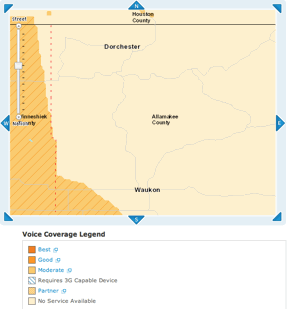
Reply comments are still open in this proceeding. vox populi, vox dei
Current ATT coverage in rural Iowa
UPDATE
FCC’s Australian counterpart, Australian Communications and Media Authority/ACMA, has a new blog entry on “Removing jammers from the streets”. Included is the above video. ACMA says
Targeting prohibited devices has demanded an agile approach to compliance. Our activities also include preventative (education/awareness) and enforcement measures. This has helped to restrict the supply of jammers to the local market, forcing consumers to turn to online sources for devices that are often seized before reaching their destination.
The Australian penalties for unauthorized jammer marketing and use are much greater than in the US. For example the blog says:
There could be more substantial penalties, such as receiving a five-year prison sentence or penalty of up to $850,000 (5,000 penalty units) for causing substantial interference to radiocommunications used by emergency services (such as fire, police and ambulance) and other special organisations. And these aren’t the only penalties that could apply.
Note from the video that ACMA, unlike the US cellular interests, is clearly able to differentiate between authorized controlled jamming in prisons and unauthorized jamming that endangers public safety. Compare this with the following CTIA video which vilified both prison jamming and unauthorized jamming based on alleged experience in Brazil.
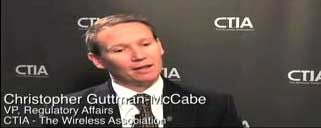
CTIA interview on prison jamming (June 2009)
UPDATE
Mr. Guttman-McCabe no longer works at CTIA and the interview on prison jamming discussed above has magically disappeared from the CTIA website. But there isn sign that CTIA's policy has changed at all.
On the Assassination of Colorado Corrections Chief Clements
Tom Clements 1955-2013

Yesterday Tom Clements, Executive Director of the Colorado Department of Corrections and a 32 year veteran of public service in the corrections area was assassinated at his home by an unknown party. This is sadly reminiscent of the attack on South Carolina Department of Corrections Captain Robert Johnson in March 2010 which is now known to have been ordered over an illicit cellphone operated in a prison.
(Capt. Johnson is now suing 20 cellular industry firms on the issue of whether they were aware of the illicit calls from the prison where he worked but chose instead “to facilitate this illegal activity.” The firms being sued are American Towers, LLC; Farmer Telephone Cooperative Inc.; Cellco Telephone Co. of the Southeast, LLC; Cellco Partnership d/b/a Verizon Wireless; Sprint Cellular Co. of South Carolina; Sprint Communications Co., L.P.; Alltel Communications, LLC; Alltel Communications, Inc.; Alltel Mobile Communications of South Carolina Inc.; T-Mobile USA Tower LLC; T-Mobile USA Inc.; ATT&T Inc.; AT&T Mobility LLC; Verizon Wireless, LLC; Verizon Wireless Service LLC; Verizon Wireless of the East, L.P.; and Tracfone Wireless, Inc.)
I recall a meeting among FCC staffers maybe a decade ago where a colleague, who has since left FCC, wondered why a manager in another part of FCC was so upset about something she said. She commented that “all we do is economic regulations” so it wasn’t “worth getting emotional about”. Well, much of what FCC does is probably “economic regulation” like local zoning and in some way determines who gets more money than another party. But Section 1 of the Communications Act also charges FCC to deal with “promoting safety of life and property through the use of wire and radio communications” and some FCC actions have life and death consequences.
It is too soon to tell for sure if the Clements assassination was connected with illicit cell phone use, but if I was Mitt Romney I would bet $10,000 that it was.
FCC now has in its “inbox” at least 3 petitions dealing with the cellphone in prisons issue that it has not acted on:
- CTIA’s November 2007 petition (Part of this petition not related to prisons was finally addressed in Docket 10-4, but the prison related issues have never been even put out for public comment)
- South Carolina Department of Corrections August 2009 petition (Signed by 30 other state and local corrections agencies)
- GTL July 2011 petition - This petition has disappeared into FCC’s petition “black hole” and is not available on the FCC’s voluminous website which promises “transparency”. However, GTL has provided us with a copy so we can make it available here. (MSS contributed to the drafting of this petition as well as the South Carolina petition. However, no present MSS clients are involved in this issue.)
Chairman Genachowski, these petitions come from a variety of parties - including a major trade association, state governments and a small company - and advocate a variety of actions - some of which are mutually inconsistent.
Isn’t it time to act on this urgent public safety issue and clarify FCC policy by dealing with these petitions one way or another?
UPDATE
No proof yet that this event was cellphone related, but it apparently also occurred to ABC News which posted a story entitled “Prison Chief's Death Highlights Safety Concerns” Here is a section:
Correctional professionals interviewed in the aftermath of the Colorado shooting say the growing influence of prison gangs, their ability to communicate with affiliates on the outside through smuggled cellphones and the ease with which people can be found and tracked online have made the job even more dangerous for them and their families.”
CTIA, why don’t we agree to both ask FCC to act one way or other on these pending petitions, including one of yours, that are gathering dust as people die.
UPDATE 2
Here is the new story about the murder of 2 prosecutors in 2 months in a rural county of Texas. District Attorney Mike McLelland and his wife, Cynthia were found murdered at their home on March 30. Assistant District Attorney Mark Hasse was killed on his way to work in January. Note that the McLelland case MO was they same as in the Clements case and the Johnson case. That does not prove that illicit cellphone use was a factor, but if I was Mitt Romney …
California Report on Prison Cell Phone Use Issues
As of July 2008, seventy-six members and fellows are also members of the National Academies, six are Nobel laureates, nine are National Medal of Science recipients and two are recipients of the National Medal of Technology.
CTIA and the major cellular carriers believe that Section 333 of the Communications Act precludes FCC from authorizing jamming of cellular communications by private sector or state or local government officials. The meaning of Section 333 has been a recurring topic here. While NTIA appears to agree with the cellular industry in this interoperation of the section, it appears that FCC has never made an en banc finding on this interpretation of the law although it is clear that under present FCC rules jamming is not authorized.
The CCST report describes managed access as:
“The Managed Access System (MAS) refers to a standard cell phone network system used in a defined close quarter geographic area such as a campus, military base or a prison. The theory behind MAS is to allow authorized cell phones to connect to the standard carrier (e.g. AT&T, Sprint, T-Mobile,Verizon) networks, while preventing unauthorized cell phones from connecting to the carrier networks. A well-designed and implemented MAS would function as a system to detect and preclude the operation of cell phones not authorized in the MAS approved database.”
CTIA and NTIA both feel that “managed access” is an effective technology for controlling cell phone use in prisons and the resulting threat to public safety. The CTIA website has the quote shown at left clearly describes managed access as “proven technology”. However, the December 2010 NTIA repot mandated by Congress does not go as far as CTIA does in saying that managed access is “proven”. NTIA merely states that “Managed access technologies hold promise as a solution” (p. 37) and that “(t)he technology requires close coordination with the FCC and wireless carriers”. NTIA also raised questions about the cost of managed access.
In contrast to CTIA’s confidence in managed access and NTIA’s optimism, CCST finds
“(T)he Managed Access System (MAS) technology of today is not mature enough for immediate large-scale deployments such as that proposed by CDCR at California’s 33 state prisons.”(p.6)
Readers who followed the Linkedin Spectrum Experts group discussion on the NTIA report may recall that Australia’s Barry Matson suggested the solution may be putting the burden on the cell operators to not connect calls from cell phones in prisons. The report independently comes to a similar suggestion:
The CCST Project Team recommends that potentially useful technology approaches be explored in confined prison areas, and that cell phone carriers be engaged to explore options of denying connections for ‘unregistered’ cell phones within prison locations using the carriers’ technology. In this latter case, identity of illegal cellular phones could be obtained via a benchmarking technology and the carrier could then deny cellular connection to the specific unregistered devices. Engaging the carriers would likely require either a legal requirement to participate or an income incentive via fee for participation. With the recent agreement of cell phone carriers with the federal government to disable services on stolen cell phones, this approach should be explored.
But even if managed access is ever to be used on a large scale it needs a better policy foundation than FCC just condoning its use. Successful managed access requires both the active participation of all the cellular carriers near a prison and detailed coordination of any technical changes to the cellular network including introduction of changes in the physical layer of the RF signal as well as new services. A successfully operating managed access system can become useless overnight and endanger public safety if one of the cellular systems in the area has an unanticipated technical change. While the major cellular carriers have indicated a willingness to accept managed access systems and sign agreements with prison authorities, they have never stated that would coordinate all technical changes and delay them as necessary until the managed access systems were upgraded. In addition, the 4 major cellular carriers are not the only carriers in the country, especially int he rural areas where maximum security prisons are often located. Indeed, future cellular auctions could well result in more corporate diversity. CCST finds
“A coordinated effort of several states to petition the FCC to modify existing spectrum owners’ agreements to require they provide unobstructed use of their spectrum within the geospatial confines of corrections facilities would be an important modification of regulations. If this effort is undertaken, the discussions could also include the possibility of using jamming technologies in some conditions.”
While the mainstream cellular industry is enthusiastic about managed access because it may allow jamming to be kept in Pandora’s Box, they have never taken a more positive step to build the policy infrastructure needed to give managed access a fair chance of success, whether or not that is really possible in the technical sense.
Sen. Grassley: Your Recent "Marimba Moment" Was Not All Your Fault - Your friends in the Cellular Industry Made It Inevitable
In January, this blog had a post entitled “Is the Cellular Industry ‘Tone Deaf’ ”? It described a 1/12/12 New York Philharmonic concert of Mahler’s 9th Symphony that was interrupted by an iPhone Marimba ringtone from a front row seat.
At the time I wrote:
The cell phone industry is united against legalizing jamming, but seems unable to do anything about antisocial cell phone usage that inevitably leads to interest by concert halls and restaurants in cellular jamming. As previously stated here, French national law explicitly permits cellular jamming in concert halls. While jamming in such urban locations inevitably will cause other problems and is thus a bad idea (as opposed to jamming in isolated maximum security prisons where the geometry is very different), there seems to have been little interest in the cellular industry in alternative approaches to minimize the antisocial aspects of cell phone use.
The cell phone industry is usually a positive contributor to US society and the US economy. But it continues to have some blind spots as outlined in the previous New Year's Resolutions post here. Maybe it should address them? Maybe FCC leadership should politely point out these issues from time to time and mention the possible impact of neglect?
In my New Year’s Resolutions for the Cellular Industry post I wrote
That post’s 7 issues attracted NO inquiries from the cellular industry which apparently is focusing all its efforts on its appetite for spectrum, not social harmony resulting from its products and services. (In fairness one high CTIA official did reply to an e-mail from me about the post and seemed puzzled why people had trouble turning off their ringers.)2. Social harmony and cell phone use. Does the cellular industry ever wonder why the public rose up in force against the Docket 04-435 proposals to allow cellphones in airplanes or why there is a market for (presently) illegal cell phone jammers? The reason is that there is a lot of obnoxious cellphone use in this country! Airplanes are one of the few places without it and the public outcry was to preserve that. There is an interesting essay by Don Norman that was prepared for a 2005 Motorola Research Visionary Board meeting entitled “Minimizing the annoyance of the mobile phone: The Annoyance, Irritation, and Frustration of The Mobile Phone -- A Design Challenge” that starts off with the quote “Nearly one in three (30%) adults say the cell phone is the invention they most hate but cannot live without”.
What is the industry doing about this? Are they trying to increase sidetone levels so people don’t shout when using cell phones? Are they trying to make it easier to switch the ringer to a vibrate only/ “manners mode” as in Japan where all carriers have voluntarily agreed that a press of the “#” key toggles the unit to and from vibrate only mode? Are they researching ways for theaters and restaurants where people really want a semblance of quiet to use Bluetooth or a similar link to switch phones automatically to vibrate only? Kudos to Motorola for inviting Dr. Norman to talk on this issue. How much of this type of dialogue is going on now in the industry?
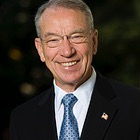
Senator Grassley, don’t feel bad about the incident. These types of things happen all the time because there is no consistent simple way to turn off the ring tone of US cell phones as there is in Japan. The cellular industry is much too busy grabbing spectrum to care about such issues of “unintended consequences”. It feels it can use its position of political strength to stop the sale of cellular jammers which people use illegally in selfdefense of obnoxious cell phone use.
In order to keep this “clear bright line” on jamming in effect, the industry even fights the use of cell phone jammers in isolated prisons where they could be a cost-effective option to enhance public safety. But apparently the cellular industry has never learned from the War on Drugs: to defeat a serious contraband issue you must address BOTH supply and demand. FCC may go through the appearances of being active against the selling of cell phone jammers, but the small and dispirited Enforcement Bureau technical staff doesn’t stand a chance against Chinese Internet marketing unless the demand is moderated also.
Sen. Grassley, at least you handled your moment much better than Sen. McCain handled his a few years ago on the Senate floor:
Some Possible New Year's Resolutions for the Cellular Industry
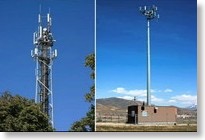
As we approach the New Year, here are some constructive suggestions for the cellular industry to think about as New Year’s resolutions. Long time readers will recognize that many have been discussed before in other contexts. Let me state first that I am a long time admirer of the cellular industry, its dynamic growth, and its general record of technical innovation. The cellular industry has also done much to improve public safety through its support for E-911, Amber Alerts, and programs to provide cell phones for domestic violence victims. But this industry has several blind spots as it has accumulated political power and FCC influence comparable to the power formerly held by entities such as the pre-divestiture AT&T, NAB, or the pre-1990 Motorola. sic transit gloria mundi
The purpose of this post is to point out constructively some of these blind spots that appear not to be in basic conflict with the fundamental goals of the industry in the hope that they may reconsider their positions in at least some of these areas. I note that while the main cellular players once were in strong opposition to the bidirectional amplifier/BDA issues now in Docket 10-4, they have moderated their position and appear to be working with responsible BDA manufacturers on technical standards for BDAs that control interference. I hope that similar reexamination is possible in the areas below:
1. Wireless technology innovation. The focus of the cellular industry is that innovation is good, but that the key to innovation is more licensed spectrum for their industry. They are happy with the current level of regulation so everyone should be also. This is clear from CTIA’s comments and reply comments in the Wireless Innovation NOI. They see no need to expedite deliberations of new technology, saying “Simply put, even for good ideas with broad appeal, resolution unfortunately can take a long time notwithstanding the desire of parties to speed the process along”. The fact that the endless drawn out FCC spectrum deliberations stifle capital formation for technical innovators is no concern for mainstream CMRS players with positive cash flow.
But Qualcomm was once a startup in an era when it got its key regulatory decision in 2 years after formation. The CDMA technology that this startup pioneered supplies a major fraction of the 2G market (VZW and Sprint) and is the core of all world’s 3G systems. But this type of disruptive wireless innovation os getting to be impossible due to regulatory stagnation but for the cellular industry and for other spectrum users that compete for cross elastic spectrum. Sadly, the cellular industry is firm with the status quo here.
Wa - harmony (Japanese)

What is the industry doing about this? Are they trying to increase sidetone levels so people don’t shout when using cell phones? Are they trying to make it easier to switch the ringer to a vibrate only/ “manners mode” as in Japan where all carriers have voluntarily agreed that a press of the “#” key toggles the unit to and from vibrate only mode? Are they researching ways for theaters and restaurants where people really want a semblance of quiet to use Bluetooth or a similar link to switch phones automatically to vibrate only? Kudos to Motorola for inviting Dr. Norman to talk on this issue. How much of this type of dialogue is going on now in the industry?
UPDATE
Suggested reading for cellular industry managers: “Wild Night at Philharmonic After Phone Interruption” describing a January 10 incident “in one of the quietest parts of the final movement of a gorgeous New York Philharmonic performance of Mahler's Ninth”.
3. Cell phones use in vehicles. Technology should improve life, not threaten it. In September 2011 NTSB recommended a ban on cell phone use in commercial vehicles (trucks and buses) after investigation of a Kentucky crash that killed 11 people. The industry was silent except for an e-mail message to your blogger saying “The wireless industry … does not oppose legislation that restricts the use of wireless communication by drivers." (This quote was never printed or posted anywhere else as far as can be determined.)
Then in December 2011 NTSB recommended to “ban the nonemergency use of portable electronic devices (other than those designed to support the driving task) for all drivers”. This time CTIA was no longer silent, saying “ As far as talking on wireless devices while driving, we defer to state and local lawmakers and their constituents as to what they believe are the most appropriate laws where they live.” This is not leadership, this is non opposition. If I was involved in a product or service that resulted in death on a regular basis as an unintended byproduct I would be a lot more concerned. Especially since talking in cars is not the main use of cell phones.
The NTSB recommendations are not perfect. For example they do not deal with new technology since all NTSB can do is investigate past accidents. Why doesn’t the industry do something more proactive like start a standards committee, or encourage DOT to start one, that can certify which technologies are safe enough for use in vehicles?
(But kudos to Sprint for breaking with the crowd and being a cosponsor of Oprah’s Oprah’s No Phone Zone website and its “No Phone Zone Pledge”.)
4. RF safety. Most of the cellular industry thinks that the public should be happy with their statements that cellphones meet FCC standards and are therefore safe. A decade ago, the industry fought FCC over the proposal to stop hiding SAR ratings for cell phone models in an obscure unmanageable database. As a previous blog post here has as a headline, “CTIA: Maybe Your RF Safety PR Strategy Isn't Working?” The past year has seen CTIA boycott San Francisco and got to court (with an initial partial victory) over a local ordinance requiring point of sale disclosure of SAR data. (The same data that Verizon Wireless openly discloses on their website for models they sell.)
Perhaps the industry does not want you to know about the secret of OETB65C. Stalin once said, “The people who cast the votes decide nothing. The people who count the votes decide everything.” So the SAR standards for cellphones in Sections 2.1091 and 2.1093 were subject to a notice and comment rulemaking that made 1.6 W/kg the SAR limit. But how is that really determined? In practice through the procedures of OETB65C which gives the manufacturers a lot of leeway as to what spacing from the simulated body they can use for measurements in the body, even if they do not provide a holder that would implement that distance and even if they don’t warn users not to put the device in their pocket. Both Time magazine and your blogger have written about this issue, but there seems denial at both FCC and industry on the issue.
There is no proof that cell phone radiation is dangerous. Indeed, some of the brain cancer claims made as clearly outrageous. (Considering there is no proof that cell phone radiation causes any pathology, why the focus on brain cancer - except that it is a very scary diagnosis.) But the web site of CTIA’s French counterpart is a lot more pragmatic than US industry sites on the risks and unknowns as well as the fact that some users may want to take extra precautions. The Swiss counterpart of EPA also has a site with pragmatic and practical information lacking in industry and government sites in the US.
5. Base stations and their environments. One of the issues driving the need for more CMRS spectrum is the difficulty of building base stations, particularly in suburban areas. Cellular capacity is a function of 3 factors: technology (e.g. 3G vs. 4G), infrastructure (number and nature of base stations, and amount of spectrum. Limits on one factor press demand on the others. For 2 decades industry has pressed Congress and FCC to limit the ability of local governments to control base station deployments with limited success. The reason is simple for the limited progress; as Tip O’Neill said famously, “All politics is local”. As long as base station designs “look like they are designed by engineers” with no regards for their surroundings in most cases, the neighbors will object.
This month’s IEEE Spectrum reports on a UK design contest for power pylons sponsored by a major electric utility, a national government agency, and the architect’s professional society, which resulted in several novel designs including the one above. Why can’t the US cellular industry help sponsor a similar contest for bold new ideas in base station design? The cost would be small compared to what they are spending on they lobbying war with the broadcasters as present.
6. “Spectrum scoring” or “How to count to 500”. The cellular industry originally demanded 800 MHz of new spectrum for CMRS although they are now accepting of the 500MHz NBP goal. But what spectrum counts towards the 500 MHz goal? Does every single Hertz have to be only in spectrum that meets standards developed in Europe to be manufactured in China? There are many types of wireless innovation other than making iPhone and iPad clones. Some of them involve using spectrum more efficiently. The focus on meeting international standards means that only innovators who want to plow through the complex international standards process can get market access in the US. Actions like PacTel’s decision to go with CDMA in the 1980s apparently is beyond consideration now.
While your blogger has no views against giving more spectrum to CMRS, many of us think the 500 MHz goal is impossible under the conditions for “counting” that the cellular industry has implicitly set with factors like nationwide 24/7 1000 ms/s access and in 3GPP specified bands. Although LTE systems can use unpaired spectrum, most of the spectrum on their wish list appears to be paired and symmetric. If FCC and NTIA come up with spectrum that doesn’t that meets all these criteria, does it “count”?
7. Provide communications for niche applications that otherwise contend for spectrum with CMRS. After the success of the iPhone, the CMRS focus seems to be on “killer apps”/knock out new products. Niche markets are of little or now interest unless they can be served with apps on standard hardware. Who needs little $100M markets. This is understandable from the MBA viewpoint.
But here is another viewpoint: Some niche markets compete for spectrum at FCC that is the same or comparable spectrum to what the cellular industry seeks. For example the medical community is clearly seeking more spectrum for short range applications. It is clear to many of us, even some in FCC, that the existing use of wireless microphones in UHF TV band “white space” is not sustainable in the long term except perhaps for uses involving only a few microphones like small churches and conference rooms - not theaters and major concerts. This is because of cellular industry pressure for UHF incentives auctions that will eventually tie up the same spectrum.
In the past, there was no alternative for the CMRS industry to serve these and other wireless niches. However, with the spectrum leasing provisions of Subpart X of Part 1 and today’s femtocell technology it is possible for cellular carriers to lease short range spectrum to users with other than standards cellular modulations/physical layers and without connection to the public network. A good example is the Qualcomm FlashLinq™ technology that will allow users to connect directly to each other with non standards modulations on spectrum leased from and under the control of a CMRS carrier. Maybe the specifics of FlashLinq™ are not perfect for the CMRS community, but it clearly shows the feasibility of new types of spectrum use in CMRS spectrum. Even if it is not a billion dollar market, its ability to “soak up” other spectrum uses that would otherwise compete for spectrum might make it attractive to openminded CMRS firms.

Until recently, the largest prepaid operator, TracFone, allowed users to activate a phone bought anonymously and “skip” the step to report name and address. However, the option of buying with cash bagfuls of prepaid phones at Walmart, activating them over the web with a false name and address, and selling them for criminal use is still quite real. Isn’t it odd that we more concerned about over-the-counter sales of Sudafed and Plan B than we are about bagfuls of anonymous cellphones?
Many countries require some identification before prepaid phones can be activated. This is a complex issue both because of the size of the market and the appeal of prepaid phones to market sectors who need them for legitimate economic and safety-related reasons but, as we know from the voter ID controversy, may lack or be unwilling to identify themselves in the standard ways. While I sincerely hope we never have a cellphone-related IED attack in this country, such an event would force a PATRIOT Act-like knee jerk reaction that could be more draconian that a deliberate process now to address the situation.
UPDATE
For those of you who wonder about the temerity of an industry outsider raising such questions about the cellular industry, let me point out the Verizon $2 “payment fee“/“convenience charge” kerfuffle that started just as this blog was first posted and ended a day later. Clearly, VZW, the largest cellular carrier in the US was out of touch with its customers on this issue and had to beat a hasty retreat. Perhaps the industry is also out of touch on the above issues?
UPDATE 2
On 1/7/12 CNN posted an article by bestselling author Bob Greene entitled “Is 2012 the year to hang up the phone?”
Story highlights:
There is growing chorus of officials, employers urging less cell phone useHe says NTSB warns against use in cars; bosses pushing back on personal calls at workHe says cell-phone distractions even affect surgeons and nurses; cut productivityIt may be impossible to take people's freedom of cell use away from them
So your blogger is not the only one seeing cell phone use backlash. Perhaps if the industry was more sensitive to the concerns listed above it might be in their own interest?

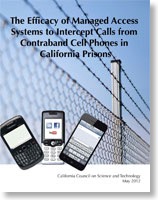
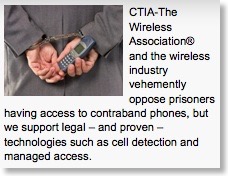






![Validate my RSS feed [Valid RSS]](valid-rss-rogers.png)

